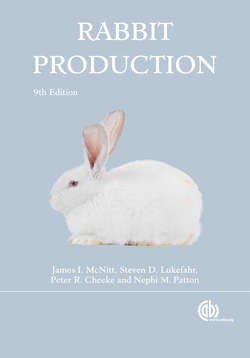Читать книгу Rabbit Production - James I McNitt - Страница 5
На сайте Литреса книга снята с продажи.
Preface
ОглавлениеRabbit Production is widely recognized as a source of up-to-date information for highly experienced rabbit raisers as well as beginners. Changes of publishers and our scientific knowledge of rabbit production methods have necessitated a revision to offer the most current information to our readers.
We have tried to write in a style that will be useful to people interested in rabbits, regardless of educational background. We hope that after reading this book you will have gained knowledge that will be useful to you in your rabbit raising endeavors. Because our new publisher (CAB International) is located in the UK, we have had to change all of our units to metric (grams, liters, meters, etc.) We have included a conversion table as Appendix 1.
Use of rabbits as a food and income resource in developing countries continues to increase, with expanding interest in Eastern Europe and in Africa, Asia, and Latin America. The ability of rabbits to reproduce and yield high quality meat on low quality diets based on forages and agricultural by-products, as well as their modest housing requirements, makes them well suited for subsistence agriculture.
In the United States and Canada, rabbits continue to be valued as a hobby and as a source of secondary income. With the current market structure, few people make their primary living from rabbits, but the enjoyment of rearing rabbits and the income and satisfaction from providing food or fiber make rabbits an inviting species. Rabbit raising is popular with youth programs and as a small-scale family enterprise because of the small size and the small investment. In addition, rabbits can be reared in many cities and towns where other livestock cannot be kept.
This book is founded on the collective many years of experience of the authors. J.I. McNitt spent a number of years in Africa as a rabbit specialist and was the leader of a rabbit research program at Southern University and A&M College. The primary goal of the research center was to assist small, limited resource farmers with production problems. As a result, most of his research was aimed at production – housing, feeding, management, etc. He retired in 1998 but remains active in writing and editing rabbit publications. N.M. Patton conducted rabbit disease research for 25 years. He has also been a consultant to a large commercial rabbitry for the past 10 years, during which time he has experienced most of the problems that rabbit raisers can encounter. In 1993, he was elected President of the World Rabbit Science Association. He retired from Oregon State University in 1996. S.D. Lukefahr has also operated his own rabbitry and has worked for many years in over 20 developing countries (especially in Africa and Latin America), where he promoted rural or village-level rabbit farming. He has been involved in rabbit breeding research since 1978, has an extensive publication record, and has made many significant contributions to our knowledge of rabbit breeding and genetics. In 1997, he was awarded the coveted International Animal Agriculture Bouffault Award for his contributions. He served as President of the World Rabbit Science Association from 2004 to 2008 and as General Secretary for Developing Countries from 2008 to 2016. P.R. Cheeke has conducted rabbit nutrition research since 1969 and has published extensively in this area. In 1985 he was awarded the prestigious Mignini International Award for excellence in rabbit research. G.S. Templeton, author of the early editions of the book, was Director of the U.S. Rabbit Experiment Station for 23 years. Thus, this book rests on a solid foundation of practical and scientific knowledge of rabbit production.
We thank our friends who have provided much assistance and insight in preparing this edition. Leslie Samson, Samson Angoras, has provided extensive assistance with the Angora chapter including rewriting the text and providing new photos for the color breed section. Susan M. Smith, of the Department of Nutritional Sciences, University of Wisconsin-Madison and the House Rabbit Society, provided assistance in revising and updating the chapter on pet rabbits. Richard Gehr, a rabbit judge and Director for the ARBA, provided assistance and insight for the chapter on Rabbit Shows.
Dr. David Harris, who worked with the former Rabbit Research Station at Oregon State University, has used his photographic skills and provided many excellent figures for this and previous editions.
